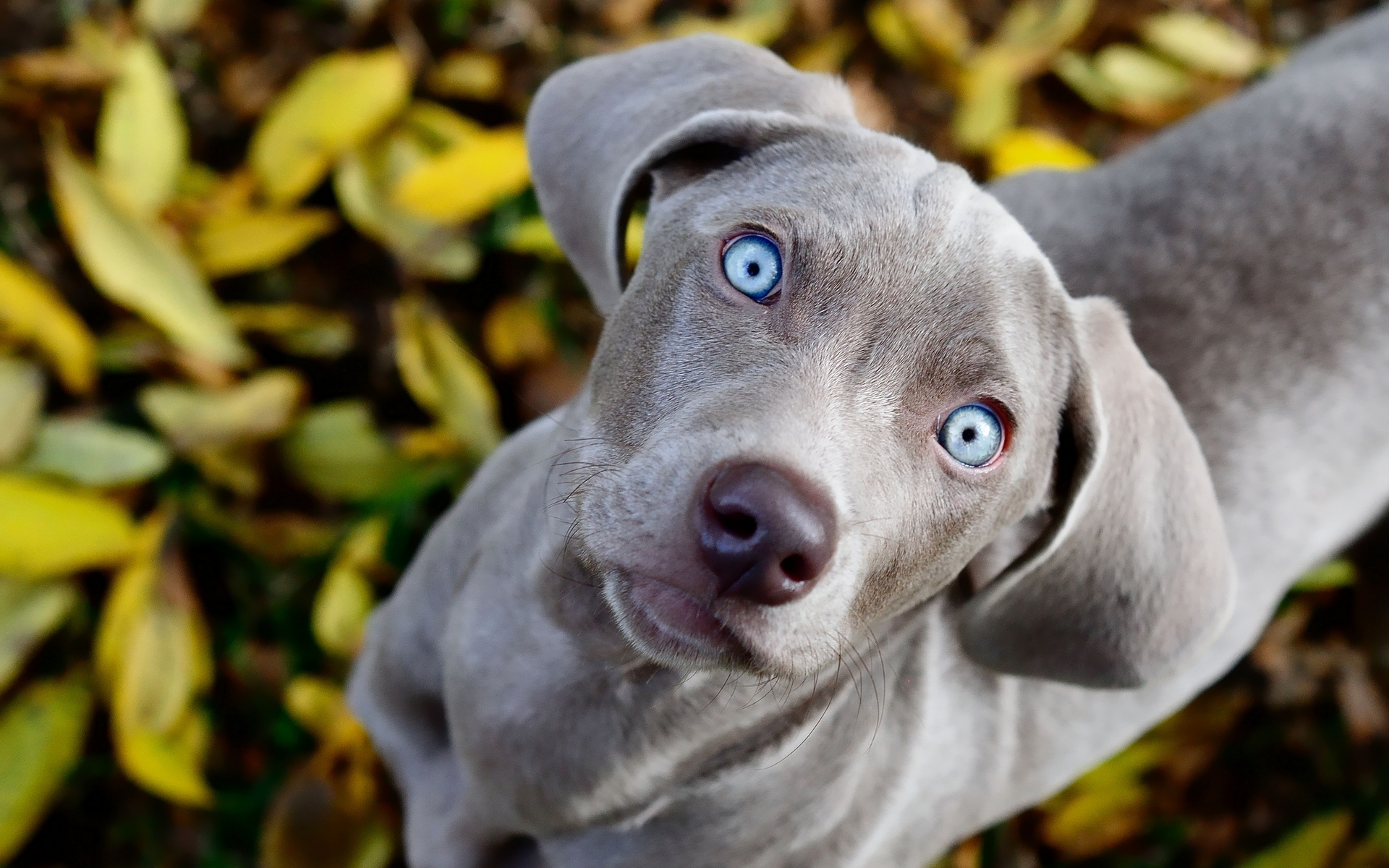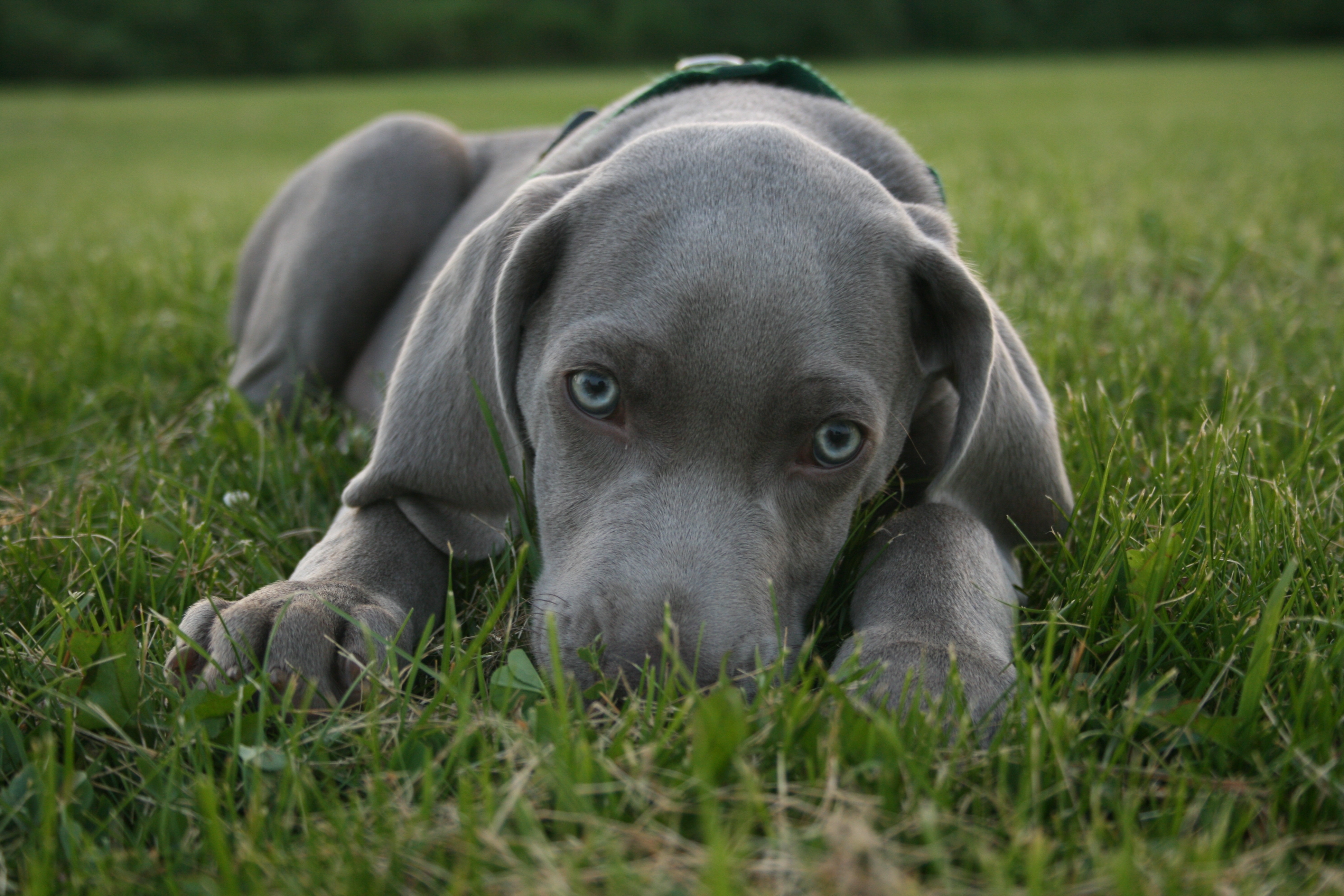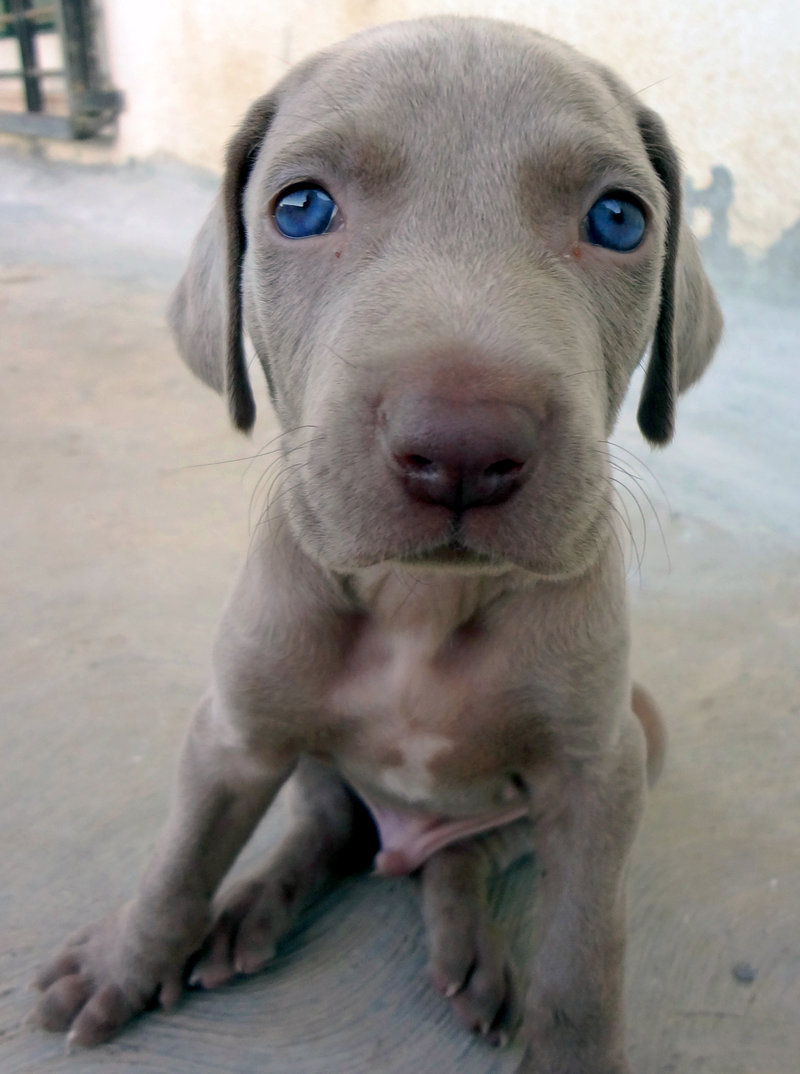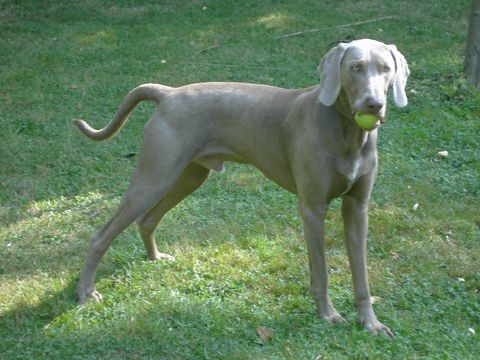
The Breed History
Weimaraners were developed by aristocrats in the 17th century
in Germany; the best known was Grand Duke Karl August of
Weimer. Breed ancestors are thought to include Pointers, German
Schweisshunds, red Haidbracke, and red Hanoverian Bloodhound
(the latter is traced back to the gray Leithunder dog of French
deer hunting stock). Weimaraners stayed exclusively owned by the
German Weimaraner club members for many years. Official breed
recognition in Germany came in 1896, and registration by the AKC
occurred in 1943. The first dogs arrived in the US in 1929.
Breeding for Function
This breed was originally selected to be an all-purpose
high-endurance hunting dog (fur and feather), bred to hunt, point
and retrieve. The most popular use for this dog in modern times
is as an obedience dog or hunting dog. They also enjoy flyball and
agility sports.
Physical Characteristics
Height at Withers: females 23-25" (58-64 cm), males 25-27"
(64-69.5 cm)
Weight: females 70-80 lb (31.8-36.4 kg), males 75-88 lb (34.1-40 kg)
Coat: The short single-layered glossy haircoat is only recognized in
the color of silver-gray to mouse-gray with a "metallic sheen"; only
one small spot of white is tolerated on the chest. Over the head,
and particularly the ears, a lighter metallic gray color is noted.
Though the longhaired Weimaraner is not recognized, this subtype
was used for waterfowl hunting. This double-coated, medium
length water resistant coat is feathered on legs and tail. There are
variations in the length, texture and volume of undercoat. A genetic
test is available.
Longevity: 10-14 years.
Points of Conformation: This aristocratic, muscular athletic
large dog possesses a medium weight mesocephalic skull with a
moderate stop and slight median line over the forehead, amber
nose, light gray, gray-blue or amber eyes, and fine leathered
pendulous large and high-set ears. Note that puppies are born with
intense sky blue eyes. They have a medium muscular neck, deep
chest and well-sprung rib cage, level loins, and a moderately tucked
waist. They possess fine long straight limbs, with small compact
feet well knuckled up and webbed. The tail is medium and tapering,
but often cropped to 6" (15 cm) adult length. Their gait is long and
straight, smooth but elastic.
Recognized Behavior Issues and Traits
Reported to be: Affectionate, keen, gentle and very obedient, but
protective. A high amount of exercise should be provided (one hour
per day minimum is recommended). High intelligence and fairly
high social needs make this dog unsuitable for kenneled life. They
should be kept busy to prevent boredom vices such as chewing.
Due to their strong chase instinct, they should be raised with, or
carefully introduced to smaller pets. They need close contact with
their owners, and are devoted, sensitive and loyal. They have low
grooming needs and are low to medium shedders. They are loud
alarm barkers.
Normal Physiologic Variations
Autosomal recessive longhaired Weimaraners occur. A genetic test
is available.
Drug Sensitivities
The breed is predisposed to vaccine-induced HOD (see below).
Recommend only using core vaccines, preferring recombinant DNA
vaccines when available, especially during puppy vaccinations.
Inherited Diseases
Hip Dysplasia: Polygenically inherited trait causing degenerative
joint disease and hip arthritis. OFA reports 8.5% affected.
Elbow Dysplasia: Polygenically inherited trait causing elbow
arthritis. OFA reports 1.8% affected.
Patella Luxation: Polygenically inherited laxity of patellar
ligaments, causing luxation, lameness, and later degenerative joint
disease. Treat surgically if causing clinical signs. Reported at a high
frequency by the OFA, but too few Weimaraners have been screened
to determine an accurate frequency.
Hyperuricosuria (HUU)/Urate Bladder Stones: An autosomal
recessive mutation in the SLC2A9 gene causes urate urolithiasis
and can predispose male dogs to urinary obstruction. Weirmaraners
have a computed 0.15 frequency of the defective gene. A genetic
test is available.
Disease Predispositions
Distichiasis: Abnormally placed eyelashes that irritate the cornea
and conjunctiva, more seriously in Weirmaraners than other breeds.
Can cause secondary corneal ulceration. Dorn reports a 1.76x odds
ratio versus other breeds. Identified in 26.67% of Weimaraners
CERF-examined by veterinary ophthalmologists between
2000-2005. CERF discourages breeding affected Weirmaraners.
Hypothyroidism: Inherited autoimmune thyroiditis. 6.9% positive
for thyroid autoantibodies based on testing at Michigan State
University. (Ave. for all breeds is 7.5%).
Cataracts: Anterior cortex intermediate cataracts predominate in
the breed. Identified in 5.60% of Weimaraners CERF-examined by
veterinary ophthalmologists between 2000-2005. CERF does not
recommend breeding any Weimaraner with a cataract.
Gastric Dilation/Volvulus (GDV, Bloat): Life-threatening twisting
of the stomach within the abdomen. Requires immediate veterinary
attention. There is a 9.1% lifetime risk of developing GDV, with
4.8% of all Weimaraners dying from the condition. Odds ratios of
4.6x to 6.2x for developing bloat versus other breeds have been
computed. A UK study shows a 5% prevalence of GVD, with it being
the cause of death of 11.6% of Weimaraners.
Hypertrophic Osteodystrophy (HOD): Immune-mediated disorder
causing fever, and painful, swollen joints and bones in young
Weimaraners. Occurs mostly within 3-14 days post-vaccination.
The disorder is not linked to a specific type of vaccine. Age of
onset is 8-16 weeks. Risk factor is 21x that of other breeds, with
an incidence of 5.4%. Reported 21.4x odds ratio versus other
breeds. One study found distemper virus contained in the affected
growth plates. This breed is prone to a severe variant of HOD that
can result in death without steroid therapy. Unknown mode of
inheritance, but the heritability of HOD in the breed is 0.68. Occurs
as a widespread disorder in the breed, with no familial line having a
greater risk.
Hormonal Urinary Incontinence: Weimaraners are found to be
a breed with increased risk for spayed females to develop urinary
incontinence. Treat with phenylpropanolamine.
Corneal Dystrophy: Epithelial/stromal form of corneal opacities.
Identified in 2.40% of Weimaraners CERF-examined by veterinary
ophthalmologists between 2000-2005.
Persistent Pupillary Membranes: Strands of fetal remnant
connecting; iris to iris, cornea, lens, or involving sheets of tissue.
The later three forms can impair vision, and dogs affected with
these forms should not be bred. Identified in 2.13% of Weimaraners
CERF-examined by veterinary ophthalmologists between 2000-2005.
Mast Cell Tumor (MCT): Skin tumors that produce histamine, and
can cause inflammation and ulceration. They can reoccur locally or
with distant metastasis. Weimaraners have a 4-8 times greater risk
for developing cutaneous mast cell tumors than other breeds.
Everted Cartilage of the Third Eyelid: A scroll-like curling of
the cartilage of the third eyelid, usually everting the margin. Can
be unilateral or bilateral, and cause ocular irritation. Identified in
1.07% of Weimaraners CERF-examined by veterinary ophthalmologists
between 2000-2005.
Follicular Dysplasia: Affected young adult Weimaraners show
progressive alopecia of the trunk (head and limbs are spared)
associated with recurrent folliculitis/furunculosis. Diagnosis by
histopathology. The lesions are similar to mild cases of color
dilution alopecia.
Spinal Dysraphism (Syringomyelia, Myelodysplasia): Congenital
spinal cord disorder seen in Weimaraners beginning at 6-8 weeks
of age. Presents as a bunny hopping gait with loss of reciprocal
hind limb movement. There can be varying degrees of loss of
proprioception and postural reactions in the pelvic limbs, with a
wide based stance. Pain perception is unaffected. Unknown mode
of inheritance. In matings between two severely affected dogs, 80%
of the offspring were affected.
Exocrine Pancreatic Insufficiency: The Weimaraner breed
has a predisposition to maldigestion from exocrine pancreatic
insufficiency based on cPLI testing.
Cervical Spondylomyelopathy (Wobbler Syndrome): Presents
with neck pain, UMN spasticity and ataxia. Imaging studies suggest
that the primary lesion is spinal cord compression at C5-6 or
C6-7. MRI is superior to myelography in determining site, severity,
and nature of the spinal cord compression. Seen at an increased
incidence in the breed. Undetermined mode of inheritance.
Immunodeficiency: Rare, familial disorder expressed as low IgA,
IgG, IgM and leading to recurrent infections of skin, GIT, and CNS.
Unknown mode of inheritance.
XX-Sex Reversal: Sry-negative XX-sex reversal causes external
make characteristics of a prepuce and an enlarged clitoris, in
genetically female dogs. A uterus is usually present. Reported as a
rare disorder in the breed. Presumed autosomal recessive mode of
inheritance.
Immunodeficient Dwarfism: Immunodeficient dwarfism in an
inbred line of Weimaraner dogs was characterized by failure to
grow, emaciation, growth hormone (GH) deficiency, decreased
lymphocyte blastogenic responsiveness to mitogens, lack of thymus
cortex, and recurrent infections usually resulting in death.
Corneal Dystrophy, Factor XI Deficiency, Lupoid Onychopathy,
Prognathism, and Tricuspid Valve Dysplasia are reported.
Isolated Case Studies
Factor VII Deficiency/Hemophilia A: Two males from a litter of
Weimaraners were diagnosed with hemophilia A. No other relatives
tested as affected or carrier, indicating a recent mutation.
Muscular Dystrophy: A 2-year-old, male Weimaraner presented
with a slowly progressive form of muscular dystrophy with organ
agenesis. He showed generalized muscle atrophy of the limbs;
hypertrophy of the neck, infraspinatus, and lingual muscles;
dysphagia; regurgitation; and unilateral renal agenesis, and hiatal
hernia.
Immune-Complex (Arthus-Type) Vasculitis: A 7-year-old
Weimaraner dog with multiple episodes of neurological illness was
euthanatized and submitted for postmortem examination. Lesions
in the white matter of the cerebral cortex and cervical spinal cord
showed necrotizing vasculitis. More chronic changes consisted of
perivascular demyelination.
Pansteatitis: Three unrelated Weimaraners were identified with
pyrexia and multiple subcutaneous nodules. Clinical investigation revealed inflammation of subcutaneous, mesenteric and falciform
fat, with histopathological findings of sterile pansteatitis. Unknown
mode of inheritance.
Hypomyelination: Two litters of Weimaraners developed tremors
by 3 weeks of age. Many axons in the brain and spinal cord were
either thinly myelinated or nonmyelinated relative to controls, while
the peripheral nervous system was normally myelinated. In all areas
of white matter evaluated, astrocytes subjectively outnumbered
oligodendrocytes, suggesting an abnormality in glial differentiation.
Clinical signs in two dogs resolved.
Juvenile Nephropathy: A two-year-old Weimaraner bitch
presented in renal failure. Renal pathology consisted of tubular
as well as glomerular lesions. There was also an inflammatory left
atrial wall necrotizing arteritis.
Endocardial Fibroelastosis: A 9-week-old Weimaraner presented
with left-sided heart failure. On necropsy, diffuse fibroplasia over
the left ventricular endocardium; small, deformed papillary muscles;
and pulmonary congestion were evident, consistent with congenital
endocardial fibroelastosis.
Narcolepsy: A 3-year-old male neutered Weimaraner dog presented
with acute onset cataplectic attacks, triggered by emotional events
such as playing or eating. The diagnosis of narcolepsy and cataplexy
was made based on clinical signs and evaluation of cerebrospinal
fluid (CSF) that contained a dramatically decreased hypocretin-1
concentration.
Genetic Tests
Tests of Genotype: Direct genetic test for HUU is available from
UC-Davis VGL and the Animal Health Trust.
Direct genetic test for long coat is available from the Animal Health
Trust and VetGen.
Tests of Phenotype: CHIC Certification: Required testing includes
hip radiographs, CERF eye examination, and thyroid profile including
autoantibodies. Optimal testing includes genetic test for HUU. (See
CHIC website; caninehealthinfo.org).
Recommend elbow radiographs, patella evaluation, and cardiac
examination.
Miscellaneous
- Breed name Synonyms: Vorsthund, Vorstenhund, Weimar
Pointer, Grey Ghost
- Registries: AKC, CKC, UKC, KCGB (Kennel Club of Great Britain),
ANKC (Australian National Kennel Club), NKC (National Kennel Club)
- AKC rank (year 2008): 31 (8,732 dogs registered)
- Internet resources: Weimaraner Club of America:
weimclubamerica.org
Weimaraner Association of Canada: weims.ca
Weimaraner Club of Great Britain:
weimaranerclubofgreatbritain.org.uk
Photo Gallery of Breed - Weimaraner - Dog Breed








 Animalia Life
Animalia Life